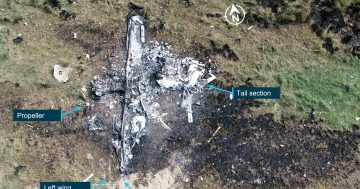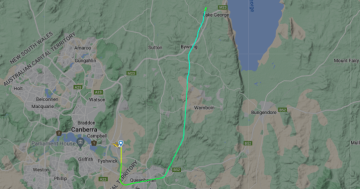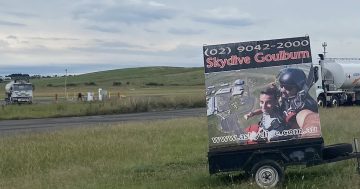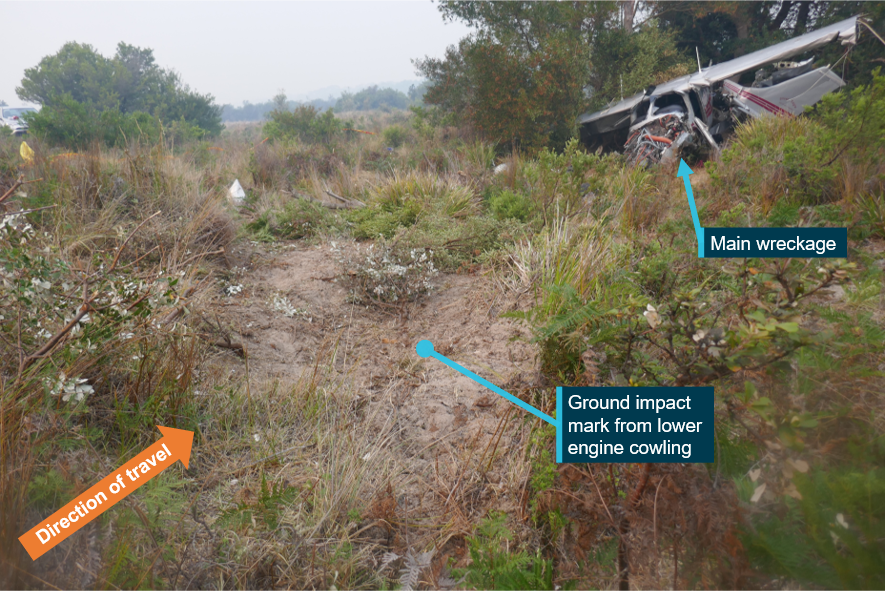
The wreckage of the plane at Moruya airport. Photo: ATSB.
Seatbelts and shoulder harnesses worn by the pilot and passenger and the close proximity of paramedics helped reduce the extent of injuries inflicted when a light aircraft crashed to the ground near Moruya airport.
Australian Transport Safety Bureau (ATSB) investigators said the prompt actions of nearby paramedics was a factor in the outcome of the forced landing of a turbine-powered Cessna 210 about 560 metres short of the runway on 19 December 2019.
While the aircraft was destroyed, the pilot survived with serious injuries and the only passenger sustained minor injuries.
The ATSB investigation found the crash followed engine failure brought about by flying in icy conditions and highlighted the importance of proper pre-flight planning.

Ice build up on the aircraft. Photo: ATSB.
The US-registered Cessna P210N Silver Eagle, a pressurised Cessna P210N re-engined with a Rolls-Royce M250 turbine, left Sydney’s Bankstown Airport for a private flight under instrument flight rules to Hobart’s Cambridge Airport on 19 December 2019.
The report found the flight was planned and conducted through forecast icing conditions although the aircraft was not certified or equipped for flight in known icing. It entered icing conditions about half an hour into the flight, shortly after reaching the cruise altitude of about 18,000 ft.
“Flight through icing conditions for an extended period resulted in significant accumulation of ice on the airframe,” ATSB Director Transport Safety Stuart Macleod said.
The pilot continued to fly in those conditions for an extended period of time before descending to 16,000 ft and deactivating the propeller de-ice and engine ice-protection systems, which in turn led to a flameout from ice ingestion.
“Attempts to restart the engine were unsuccessful, most probably because of a phenomenon known as rotor lock – where rapid and differential cooling of the engine’s components temporarily prevents it from rotating,” Mr Macleod explained.
Without engine power, the pilot conducted a glide approach towards Moruya Airport.
“While the pilot was able to get near the airport, the subsequent manoeuvring compromised the ability to remain visual with the airport and assess the glide approach, resulting in the aircraft being too low to reach the most appropriate runway,” Mr Macleod said.
“Subsequent distraction led to a misjudged approach to the remaining runway options.”
The aircraft hit the ground about 560 m north of the runway and was destroyed.
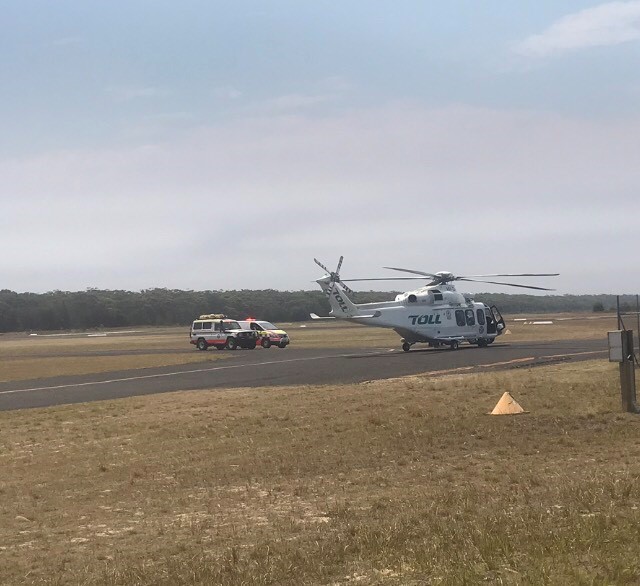
Emergency services responding to the accident at Moruya Airport. Photo: Alex Rea.
“This investigation highlights that thorough knowledge of an aircraft’s limitations and systems, in combination with an understanding of hazardous weather and aviation meteorological products, is critical to safe and effective flight operations,” said Mr Macleod.
“Icing conditions can be extremely hazardous to aircraft. Every icing encounter, to some extent, is unique and unpredictable.”
Mr Macleod stressed that pilots should carefully evaluate all available relevant meteorological information when determining whether icing conditions are likely along the planned flight path.
“Where the aircraft is not certified or equipped to operate in icing conditions, any ice-protection systems on the airframe, propeller or engine, should be regarded as a means to provide time to exit unexpected icing conditions, not to continue to operate in those conditions,” he said.
The ATSB investigation emphasised that practice and proficiency in simulated forced landings and power-off approaches could improve the likelihood of successfully managing emergency situations.
“Although forced landings can occur in a variety of circumstances, in general, pilots should focus on remaining visual with the intended landing area in order to accurately assess the aircraft’s performance in glide, and reach key decision points to refine the course of action,” Mr Macleod said.
The investigation also identified a number of other factors associated with pre‑flight preparation and the operation of the aircraft and its systems.






